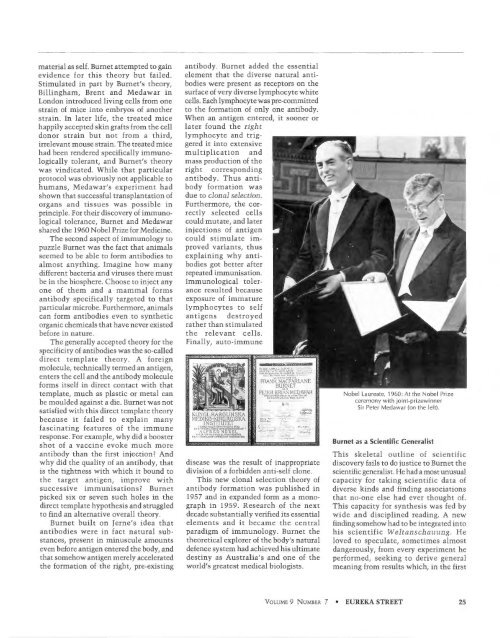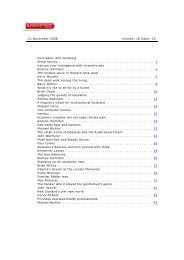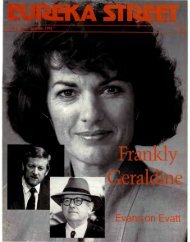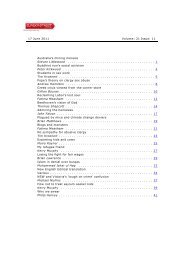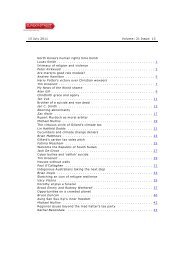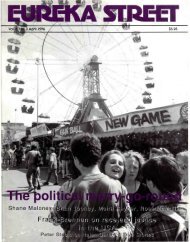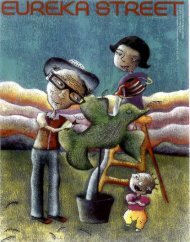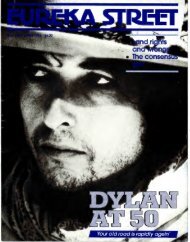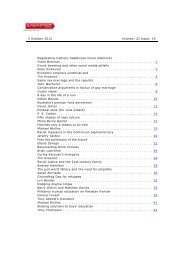1 - Eureka Street
1 - Eureka Street
1 - Eureka Street
- No tags were found...
Create successful ePaper yourself
Turn your PDF publications into a flip-book with our unique Google optimized e-Paper software.
material as self. Burnet attempted to gainevidence for this theory but failed.Stimulated in part by Burnet's theory,Billingham, Brent and Medawar inLondon introduced living cells from onestrain of mice into embryos of anotherstrain. In later life, the treated micehappily accepted skin grafts from the celldonor strain but not from a third,irrelevant mouse strain. The treated micehad been rendered specifically immunologicallytolerant, and Burnet's theorywas vindicated. While that particularprotocol was obviously not applicable tohumans, Medawar's experiment hadshown that successful transplantation oforgans and tissues was possible inprinciple. For their discovery of immunologicaltolerance, Burnet and Medawarshared the 1960 Nobel Prize for Medicine.The second aspect of immunology topuzzle Burnet was the fact that animalsseemed to be able to form antibodies toalmost anything. Imagine how manydifferent bacteria and viru es there mustbe in the biosphere. Choose to inject anyone of them and a mammal formsantibody specifically targeted to thatparticular microbe. Furthermore, animalscan form antibodies even to syntheticorganic chemicals that have never existedbefore in nature.The generally accepted theory for thespecificity of antibodies was the so-calleddirect template theory. A foreignmolecule, technically termed an antigen,enters the cell and the antibody moleculeforms itself in direct contact with thattemplate, much as plastic or metal canbe moulded against a die. Burnet was notsatisfied with this direct template theorybecause it failed to explain manyfascinating features of the immuneresponse. For example, why did a boostershot of a vaccine evoke much moreantibody than the first injection? Andwhy did the quality of an antibody, thatis the tightness with which it bound tothe target antigen, improve withsuccessive imm unisa tions? Burnetpicked six or seven such holes in thedirect template hypothesis and struggledto find an alternative overall theory.Burnet built on J erne' idea thatantibodies were in fact natural substances,present in minuscule amountseven before antigen entered the body, andthat somehow antigen merely acceleratedthe formation of the right, pre-existingantibody. Burnet added the essentialelement that the diverse natural antibodieswere present as receptors on thesurface of very diverse lymphocyte whitecells. Each lymphocyte was pre-committedto the formation of only one antibody.When an antigen entered, it sooner orlater found the rightlymphocyte and triggeredit into extensivemultiplication andmass production of theright correspondingantibody. Thus antibodyformation wasclue to clonal selection.Furthermore, the correctlyselected cellscould mutate, and laterinjections of antigencould stimulate improvedvariants, thusexplaining why antibodiesgot better afterrepeated immunisation.Immunological toleranceresulted becauseexposure of immaturelymphocytes to selfantigens de troyedrather than stimulatedthe relevant cell .Finally, auto-immunedisease was the result of inappropriatedivision of a forbidden anti-self clone.This new clonal selection theory ofantibody formation was published in195 7 and in expanded form as a monographin 1959. Research of the nextdecade substantially verified its essentialelements and it became the centralparadigm of immunology. Burnet thetheoretical explorer of the body's naturaldefence system had achieved his ultimatedestiny as Australia's and one of theworld's greatest medical biologists.Nobel Laurea te, 1960: At th e Nobel Pri zeceremony with joint-prizewinnerSir Peter M edawar (on th e left).Burnet as a Scientific GeneralistThis skeletal outline of scientificdiscovery fails to do justice to Burnet thescientific generalist. He had a most unusualcapacity for taking scientific data ofdiverse kinds and finding associationsthat no-one else had ever thought of.This capacity for synthesis was feel bywide and disciplined reading. A newfinding somehow had to be integrated intohis scientific Weltanschauung. Heloved to speculate, sometimes almostdangerously, from every experiment heperformed, seeking to derive generalmeaning from results which, in the firstVoLUME 9 NuMBER 7 • EUREKA STREET 25


